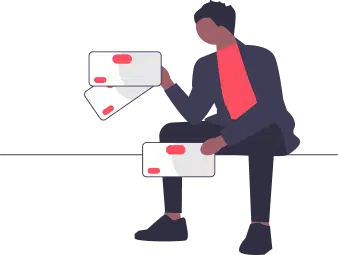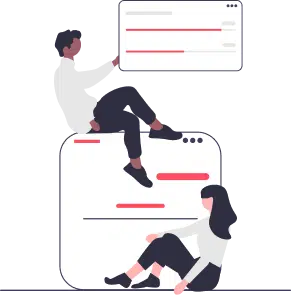Our Process
Explainer Video Animation Creation Process?
Creating an explainer video involves a detailed and structured process to effectively convey information and engage the audience. Here’s an overview of the process: It starts with understanding the target audience and defining key messages, followed by script writing, storyboarding, and producing visuals and animations, and ends with editing and integrating voiceovers and music to create a cohesive and impact video.
01
Define Objectives and Audience
- Set Goals: Identify the purpose of the explainer video. This might include explaining a concept, promoting a product, or outlining a service.
- Understand the Audience: Determine who the target audience is, their needs, and their preferences to tailor the content appropriately.


02
Scriptwriting
- Develop the Script: Write a clear, concise, and engaging script. Focus on straightforwardly conveying the main message, with a logical flow and a compelling call to action.
- Refine the Message: Ensure the script is easy to understand and avoids jargon, making it accessible to the target audience.
03
Storyboarding
- Create Storyboards: Develop a storyboard to outline the visual sequence of the video. This includes sketches or diagrams that illustrate how each part of the script will be visualized.
- Plan Transitions: Include notes on transitions, visual effects, and key elements to ensure a smooth flow between scenes.

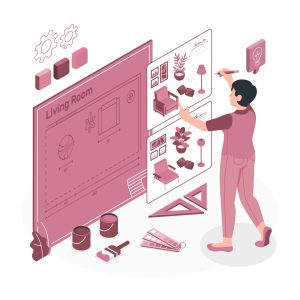
04
Design and Asset Creation
Then, we work on the animatics or storyboard – the last pre-production step. It’s a visual guide for defining still frames and scene-wise shots. Background music and recording voiceovers are also a part of it.
05
Voice-over Recording
- Record Voice-over: Record the voice-over narration that will guide the video. Ensure the voice-over is clear, professional, and matches the tone and pacing of the script.
- Sync with Animation: Make sure the voice-over timing aligns with the visual elements of the video.


06
Animation and Production
- Create Animations: Animate the visual elements according to the storyboard. This involves bringing characters and graphics to life through movement and interaction.
- Integrate Visuals and Audio: Combine the animated visuals with the voice-over and any background music or sound effects.
07
Sound Design
- Add Music and Effects: Incorporate background music and sound effects to enhance the overall experience. Choose audio elements that complement the visuals and reinforce the message.
- Adjust Levels: Ensure that the audio levels are balanced and that the voice-over is clear and audible.


08
Editing and Refinement
- Edit the Video: Assemble the final video, adjusting timing, transitions, and visual effects as needed. Ensure the video flows smoothly and maintains viewer engagement.
- Review and Revise: Conduct a thorough review to identify any issues or areas for improvement. Make necessary revisions to enhance clarity and impact.
09
Final Review and Approval
- Seek Feedback: Present the video to stakeholders or clients for feedback. Ensure it meets their expectations and objectives.
- Make Final Adjustments: Implement any final changes based on feedback to ensure the video is polished and effective.


10
Export and Distribution
- Export the Video: Render and export the final video in the appropriate format and resolution for the intended platform or distribution channel.
- Distribute: Publish or share the video through channels such as websites, social media, email campaigns, or presentations.
11
Monitoring and Evaluation
- Track Performance: Monitor the video’s performance through metrics such as views, engagement, and feedback.
- Evaluate Success: Analyze the results to assess how well the video met its objectives and identify any areas for improvement in future projects.

2D Explainer Animation Development Process?
Creating a 2D explainer animation involves several key steps to ensure a high-quality, engaging video. Here’s an overview of the process: It starts with concept development and script writing, followed by storyboarding and creating visual assets, and concludes with animation, voice-over recording, and final editing to deliver a clear and compelling message.
01
Objective and Audience Definition
- Define Objectives: Determine the purpose of the explainer video, such as explaining a concept, showcasing a product, or delivering a message.
- Identify Audience: Understand the target audience to tailor the content, tone, and style of the animation to their needs and preferences.


02
Scriptwriting
- Develop the Script: Write a clear and concise script that outlines the key message, main points, and the call to action. The script should be engaging and easy to understand, with a logical flow.
03
Storyboarding
Create Storyboards: Develop storyboards to visualize the sequence of scenes and how the script will be illustrated. This step involves sketching rough drafts of each scene and planning the animation flow.
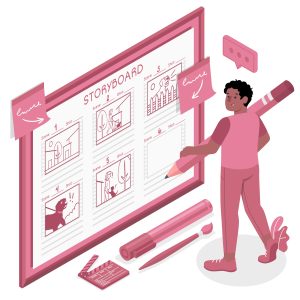
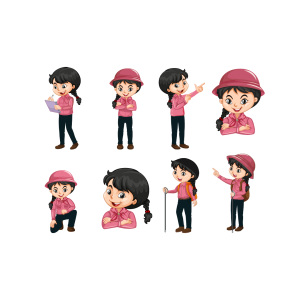
04
Character and Asset Design
- Design Characters: Create character designs that fit the style and tone of the video. Characters should be visually appealing and aligned with the message.
- Design Assets: Design other visual elements, such as backgrounds, icons, and props, that will be used in the animation. Ensure they are consistent with the overall design style.
05
Voice-over Recording
Record Voice-over: Record the voice-over that will narrate the script. Ensure the narration is clear, engaging, and matches the pacing of the animation.


06
Animation and Production
- Animate Scenes: Create animations based on the storyboard and design assets. This involves bringing characters and elements to life through movement and interaction.
- Sync with Voice-over: Ensure that the animation syncs with the voice-over, matching the timing and rhythm of the narration.
07
Sound Design
- Add Background Music: Select or compose background music that complements the video’s tone and enhances engagement.
- Incorporate Sound Effects: Add sound effects to emphasize actions and enhance the overall viewing experience.


08
Editing and Refinement
- Edit the Animation: Assemble and refine the animation, ensuring smooth transitions, consistent timing, and alignment with the voice-over.
- Review and Revise: Conduct a review to identify any issues or areas for improvement. Make necessary revisions to enhance clarity and engagement.
09
Final Review and Approval
- Finalize the Video: Conduct a final review to ensure the video meets quality standards and effectively communicates the message.
- Seek Approval: Get feedback from stakeholders or clients and make any final adjustments as needed.


10
Export and Distribution
- Export the Video: Export the final animation in the desired format and resolution, suitable for the intended platform (e.g., web, social media, or presentations).
- Distribute: Publish or distribute the video through appropriate channels to reach the target audience.
11
Monitoring and Evaluation
- Monitor Performance: Track the video’s performance and gather viewer feedback to assess its effectiveness.
- Evaluate Results: Analyze the feedback and performance metrics to evaluate the success of the animation and identify opportunities for future improvements.

3D Character Animation Production Process?
Creating a 3D character animation involves a detailed and methodical approach to ensure a captivating and lifelike result. Here’s a breakdown of the process: It includes modeling and texturing the character, rigging for movement, animating sequences, and fine-tuning with lighting and rendering to achieve a polished and immersive animation.
01
Concept and Design
- Character Design: Start by designing the characters, including their appearance, personality, and distinctive features. Create concept art and design sheets to establish the character’s look and style.
- Story and Script: Develop a story or script that outlines the character’s role and actions. This helps guide the animation and ensures the character’s movements align with the narrative.
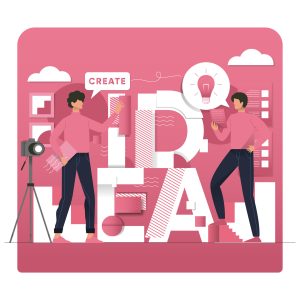
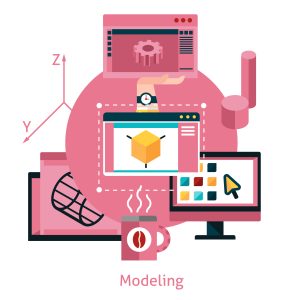
02
Modeling
- 3D Modeling: Build the character model using 3D software. This involves creating the character’s mesh, including detailed features and anatomy.
- Texturing: Apply textures to the 3D model to add color and surface details. This includes creating UV maps and painting textures to enhance realism.
03
Rigging
- Skeleton Creation: Construct a digital skeleton (rig) for the character, including bones, joints, and control systems. This rig will be used to animate the character.
- Skinning: Bind the character’s 3D model (skin) to the rig. Skinning involves defining how the mesh deforms with the rig’s movements.
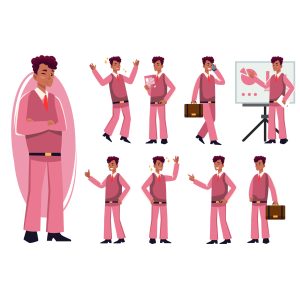

04
Animation
- Blocking: Create key poses and main actions for the character. This phase focuses on defining the major movements and timing.
- In-Bet weening: Add intermediate frames between key poses to ensure smooth transitions and fluid motion. This step refines the animation.
- Polishing: Fine-tune the animation by adjusting timing, adding secondary movements, and ensuring the motion is natural and expressive.
05
Lighting and Rendering
- Lighting: Set up lighting in the scene to highlight the character and create the desired mood. Experiment with different lighting setups to achieve the best effect.
- Rendering: Render the animation to generate the final frames. This process calculates the final image data, including lighting, textures, and effects.


06
Compositing and Effects
- Compositing: Combine rendered frames with additional elements such as backgrounds, special effects, and overlays. Ensure the character blends seamlessly into the scene.
- Adding Effects: Incorporate visual effects like shadows, glows, or particle effects to enhance the animation and add depth.
07
Editing and Post-Production
- Editing: Assemble the rendered frames into a coherent sequence. Edit the animation to ensure smooth transitions and proper timing.
- Sound and Music: Add sound effects, dialogue, and music to complement the animation and enhance the viewer’s experience.


08
Final Review and Revisions
- Review: Conduct a thorough review of the animation to identify any issues or areas for improvement. Gather feedback from stakeholders or team members.
- Revisions: Make necessary adjustments based on feedback to ensure the final animation meets quality and creative standards.
09
Export and Distribution
Export: Export the final animation in the desired format and resolution. Prepare it for distribution through platforms such as film, video games, or online channels.


10
Feedback and Evaluation
- Feedback: Collect feedback from the audience and stakeholders to assess the animation’s effectiveness.
- Evaluation: Analyze the animation’s performance and identify areas for improvement in future projects.
Whiteboard Video Animation Creation Process?
Creating an effective whiteboard video involves a detailed process to ensure clarity and engagement. Here’s a step-by-step breakdown of the process: This includes scripting and storyboarding, followed by hand-drawn illustrations and animation, and concludes with voice-over recording and final editing to enhance the video’s educational value and viewer appeal.
01
Define Objectives and Audience
- Start by understanding the purpose of the whiteboard video and identifying the target audience. This helps tailor the content to meet specific goals and resonate with viewers.


02
Scriptwriting
- Develop a script that outlines the message and key points to be communicated. The script should be clear, concise, and engaging, with a logical flow that guides the viewer through the content.
03
Storyboard Creation
- Create a storyboard to visually plan each scene of the video. This involves sketching out the main ideas and how they will be illustrated on the whiteboard. The storyboard serves as a blueprint for the animation process.
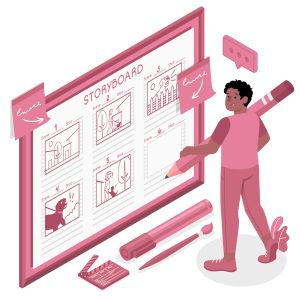

04
Voice over Recording
- Record a voice-over that narrates the script. The voice-over should be clear, engaging, and well-paced to complement the visual elements of the video.
05
Design and Illustrate
Design and create the illustrations that will be drawn on the whiteboard. These should be simple yet effective, clearly representing the key concepts and enhancing the message.


06
Animation Production
- Animate the whiteboard drawings to match the voiceover. This involves simulating the hand-drawn effect, where illustrations appear to be created in real time. Ensure that the animation aligns with the pacing of the voice-over.
07
Add Background Music and Sound Effects
- Incorporate background music and sound effects to enhance the video’s appeal and maintain viewer engagement. Ensure that these elements complement the voice-over and do not overpower it.
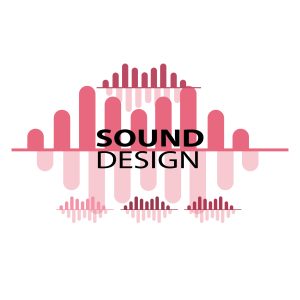

08
Editing and Refinement
- Edit the video to ensure a smooth flow and cohesive presentation. This includes synchronizing the voice-over with the animation, adjusting timing, and making any necessary revisions to improve clarity and engagement.
09
Final Review and Approval
Conduct a final review of the video to check for any errors or inconsistencies. Gather feedback from stakeholders and make any final adjustments before the video is finalized.


10
Export and Distribution
- Export the video in the desired format and resolution. Distribute the video through the appropriate channels, such as websites, social media, or email campaigns, to reach the intended audience.
Anime Video Animation Production Process?
Creating an anime video involves a detailed and artistic process to bring characters and stories to life. Here’s an overview of the process: It encompasses storyboarding, character design, and animation, followed by meticulous editing and sound design to ensure the final product captures the intended emotion and style.
01
Concept Development
- The process begins with conceptualizing the anime. This includes developing the story, creating characters, and outlining the plot. Writers and creators establish the thematic elements and overall vision for the anime.


02
Scriptwriting and Storyboarding
- The script outlines the dialogue, actions, and key scenes. Storyboarding involves sketching out the major scenes and sequences to visualize the flow of the anime. Storyboards act as a blueprint for the animation process.
03
Character Design
Character designers create detailed character designs, including their appearance, clothing, and expressions. These designs are essential for maintaining consistency throughout the animation.
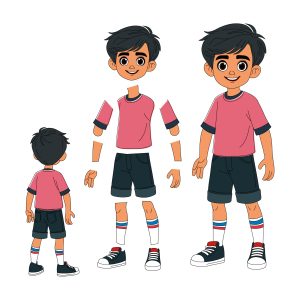

04
Background Design
- Background artists design the settings and environments where the characters will interact. These backgrounds help establish the world of the anime and provide context for the story.
05
Voice Acting and Audio Production
Voice actors record the dialogue based on the script. Sound effects and music are also created or sourced to complement the visuals and enhance the overall experience.
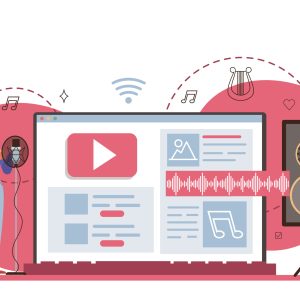

06
Animation Production
This step involves several stages:
- Key Animation: Key animators create the keyframes that define the main actions and movements in a scene.
- In-Between Animation: In-between animators fill in the gaps between keyframes to create smooth transitions and fluid motion.
- Cleanup and Line Art: The final line art is cleaned up and refined from rough sketches to ensure clarity and consistency.
07
Coloring and Compositing
- After line art, the animation cells are colored. Compositing involves layering these cells with backgrounds, effects, and any additional elements to create the final animated scenes.


08
Editing and Post-Production
- The completed animation is edited to ensure that the timing, pacing, and overall flow are smooth. This stage also includes adding final touches, such as special effects and final color corrections.
09
Final Review and Adjustments
The completed anime undergoes a review process where feedback is gathered and any necessary adjustments are made. This step ensures that the anime meets the creative vision and quality standards.


10
Distribution and Release
- Once finalized, the anime is prepared for distribution. This could involve broadcasting, streaming, or physical release, depending on the intended platform and audience.
Video Editing Process and Workflow?
The video editing process involves several key steps to transform raw footage into a polished final product. Here’s an overview of the process: From initial footage selection to color correction and sound design, each phase refines the content to ensure a cohesive and engaging final video.
01
Pre-production Planning
Before editing begins, it’s crucial to plan. This includes outlining the video’s structure, creating a storyboard, and organizing the footage. Scriptwriting and scheduling may also be part of this phase.
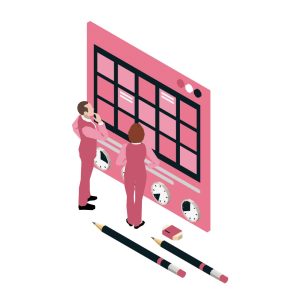
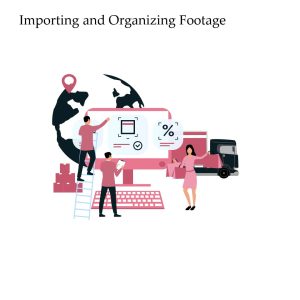
02
Importing and Organizing Footage
- Raw footage is imported into the editing software. It’s then organized into bins or folders, categorized by scenes, takes, or other criteria to streamline the editing process.
03
Rough Cut
The first step in the editing is the rough cut, where the editor assembles the footage in a basic sequence. This stage focuses on getting the overall structure right, without fine-tuning details.

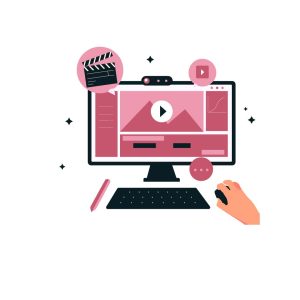
04
Fine Cut
After the rough cut, the fine cut refines the sequence. The editor focuses on tightening the edits, improving transitions, and ensuring the narrative flows smoothly. This version is closer to the final product.
05
Adding Effects and Graphics
Visual effects, graphics, and animations are incorporated. This might include text overlays, transitions, and special effects to enhance the video’s appeal and convey its message effectively.

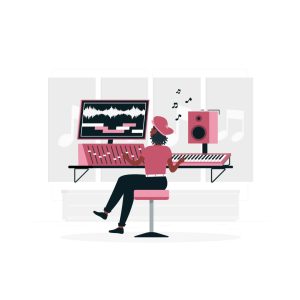
06
Audio Editing
The audio track is refined, which involves adjusting levels, adding background music, and sound effects, and ensuring that dialogue is clear and synchronized with the video. This step is crucial for maintaining the overall quality of the video.
07
Color Correction and Grading
The video’s color scheme is adjusted to ensure consistency and achieve the desired look. Color correction fixes any issues with exposure and white balance, while color grading sets the tone and mood of the video.


08
Final Review and Revisions
The editor reviews the video, checking for any errors or inconsistencies. Feedback is gathered from stakeholders or clients, and revisions are made to address any issues.
09
Exporting and Delivery
Once the final version is approved, the video is exported in the desired format and resolution. The final product is then delivered to the client or published on the intended platform.


10
Archiving
Finally, all project files and footage are archived for future reference or potential updates. This ensures that the project can be revisited or modified if needed.
Customer Testimonials
Throughout our journey, Animotions Studio has consistently delivered high-quality projects. Here’s what our valued customers have to say about our video production services.
I am incredibly pleased with the video animationsstudio created for me. His work exceeded my expectations in every way. Throughout the project, animationsstudio demonstrated remarkable patience, ensuring that every change I requested was implemented to perfection. His collaborative spirit and willingness to go the extra mile made the entire process smooth and enjoyable.
Hired by Pronto Intervento
Pronto Intervento Jun 8 - Jun 20
“I had the pleasure of working with animotionsstudio on a video animation project, and I couldn’t be more impressed with his work ethic and quality of design. animotionsstudio delivered a high-quality video that perfectly captured our vision. He consistently went above and beyond, often doing additional work to ensure the final product exceeded our expectations. His attention to detail and dedication to the project were exceptional. I highly recommend animotionsstudio for any video animation or design projects.
Hired by Liam Mistry
STLBS Jun 20
“I came to Ghazanfar with a last min request for animations that I needed for a Webflow website with a very short timeline and he was extremely knowledgeable in making sure that we had the right type of files for Webflow for the animations (Lottie files) and he was able to also help implement them and transitions throughout the site. He did a great job and provided great support and advice throughout working together. I would definitely recommend him and look forward to working together in the future
Hired by Carly Jefferson
Carly Jefferson Jun 3 - Jun 7
We are thrilled with the animation video created for our website. Creativity and professionalism exceeded our expectations. The animation perfectly captures our brand’s essence and has already received fantastic feedback from our visitors. Communication was seamless, and the project was delivered on time. We highly recommend for his outstanding work!
